Related Research Articles
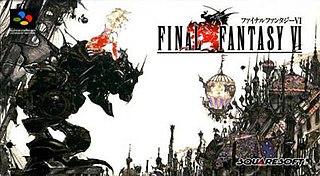
Final Fantasy VI, also known as Final Fantasy III from its initial North American release, is a 1994 role-playing video game developed and published by Square for the Super Nintendo Entertainment System. It is the sixth main entry in the Final Fantasy series, the final to feature 2D sprite based graphics, and the first to be directed by someone other than series creator Hironobu Sakaguchi; the role was instead filled by Yoshinori Kitase and Hiroyuki Ito. Long-time collaborator Yoshitaka Amano returned as character designer and concept artist, while composer Nobuo Uematsu returned to compose the game's score, which has been released on several soundtrack albums.

Cloud Strife is the protagonist of Square Enix's role-playing video game Final Fantasy VII (1997), Final Fantasy VII Remake (2020), Final Fantasy VII Rebirth (2024) & the computer-animated movie Final Fantasy VII: Advent Children (2005). He acts in a supporting role in other Compilation of Final Fantasy VII titles, and is featured in several other games in the wider Final Fantasy series. He has also made guest appearances in various titles outside the franchise, such as the Kingdom Hearts series by Square Enix and Disney and the Super Smash Bros. series by Nintendo.

Sephiroth is a character in the Final Fantasy series and the main antagonist of the video game Final Fantasy VII developed by Square. He is a mutated human, formed from the cells of an alien lifeform and an unwanted fetus. A former soldier of the megacorporation Shinra and the coworker of Zack Fair as well as the superior of main protagonist Cloud Strife, he possesses superhuman physiology as a result of an experiment in which Shinra injected him with cells from the extraterrestrial lifeform Jenova when he was still a fetus. Upon discovering this, Sephiroth becomes consumed by rage and decides to take control of the Planet by harnessing its life force and annihilating all life on it in order to become a god amidst the destruction. Sephiroth's background and role in the story are expanded upon in the Compilation of Final Fantasy VII. Additionally, he appears as a guest character in other video games and media, such as a recurring boss in the Kingdom Hearts series and as a playable character in Super Smash Bros. Ultimate.
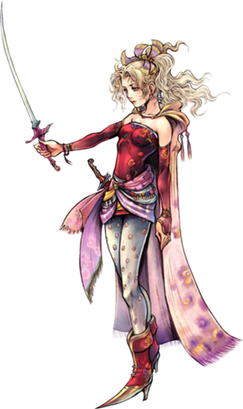
Terra Branford, known as Tina Branford in Japanese media, is a character in the Final Fantasy series and the main protagonist of Final Fantasy VI. Yoshitaka Amano and Tetsuya Nomura designed her for the main series installment, with Kazuko Shibuya designing her in-game sprites alongside the rest of the characters. She also appears in the spin-off fighting game series Dissidia Final Fantasy and the rhythm series Theatrhythm Final Fantasy. She has made small appearances in several other games in and outside the Final Fantasy series.
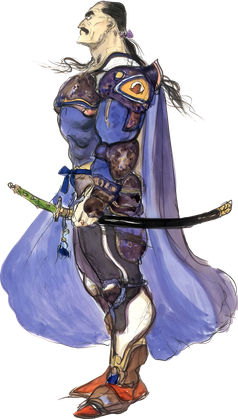
Cyan Garamonde, known in Japan as Cayenne Garamonde, is a character introduced in the 1994 role-playing video game Final Fantasy VI by Square Enix. A samurai, he serves the Kingdom of Doma. However an invading Empire poisons its water supply, and as a result its citizens are killed, including Cyan's wife and child. Driven by grief he seeks revenge against the Empire and joins the game's roster of playable characters. He has since appeared in other games related to the Final Fantasy franchise, including Dissidia Final Fantasy Opera Omnia, where he is voiced by Ryūzaburō Ōtomo.
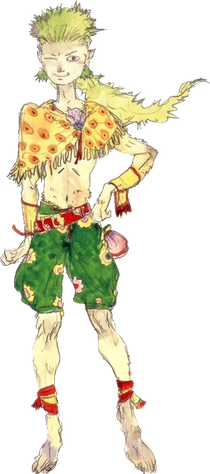
Gau is a character introduced in the 1994 role-playing video game Final Fantasy VI by Square Enix. A feral child, Gau was raised by animals in the game's Veldt location after his father abandoned him as an infant, and later develops a familial bond with the characters Cyan and Sabin after they offer him food. Unlike other characters in the game, he fights specifically using enemy movesets the player can learn through using him against enemy encounters on the Veldt, though this renders him unable to be controlled for the duration of the fight. He has since appeared in other games related to the Final Fantasy franchise, including Dissidia Final Fantasy Opera Omnia, where he is voiced by Tomo Muranaka.

Celes Chere is a character and protagonist in the video game Final Fantasy VI. She was created by Yoshinori Kitase and was his favorite character in the game. She struggles with allegiances between the Empire and the rebel group, the Returners before ultimately siding with the latter. She appears in other Final Fantasy titles, including the Theatrhythm series and World of Final Fantasy.

Setzer Gabbiani is a character introduced in the 1994 role-playing video game Final Fantasy VI by Square Enix. A gambler with an airship casino, he originally plots to kidnap the starlet of an opera, before he is coerced into joining the protagonists in their quest to stop the game's Gestahlian Empire. Created by Tetsuya Nomura, he was based on a character class he had originally planned for the game's preceding title, Final Fantasy V. He has since appeared in other titles related to the Final Fantasy franchise, including Kingdom Hearts II, where he is voiced by Crispin Freeman in English, and Ryōtarō Okiayu in Japanese.

Kefka Palazzo is a video game character and the main antagonist in the 1994 Square role-playing video game Final Fantasy VI. Yoshitaka Amano created his visual design and director Yoshinori Kitase wrote his scenes. He is one of the most well-known and well-received villains in the Final Fantasy series. His popularity led to featured roles in the fighting game Dissidia Final Fantasy and its sequels. He also appears as an enemy boss character in games including Theatrhythm Final Fantasy, Final Fantasy Artniks, Final Fantasy XIV: Stormblood, and Final Fantasy All the Bravest.
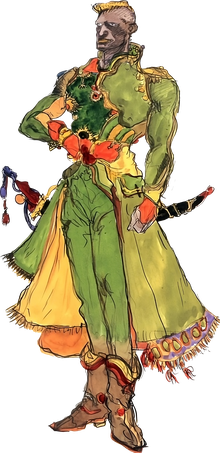
Leo Cristophe more commonly referred to as General Leo, is a character introduced in the 1994 role-playing video game Final Fantasy VI by Square Enix. An honorable soldier in the game's Gestahlian Empire that refused the magical energy infusion given to his compatriots, he appears in the first half of the game helping to ensure his Emperor's expansionist goals and is betrayed in the end. He has since appeared in other games related to the Final Fantasy franchise, including Dissidia Final Fantasy Opera Omnia, where he is voiced by Masashi Sugawara.
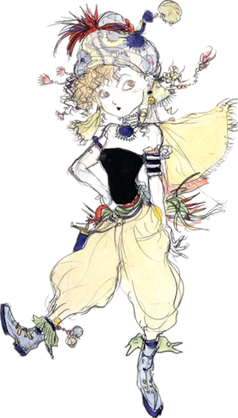
Relm Arrowny is a character in the 1994 video game Final Fantasy VI. She is one of the last characters recruited into the main party, and is often accompanied by her grandfather, Strago Magus. Her mother died when she was young, and her father later left her. Despite her father, Shadow, eventually reuniting with her, she never learns his true identity. She was designed by various people; Yoshitaka Amano, Tetsuya Nomura, and Kazuko Shibuya all do art for her, while Akiyoshi Ota and other writers devised her backstory.
The music of the video game Final Fantasy VI was composed by regular series composer Nobuo Uematsu. The Final Fantasy VI Original Sound Version, a compilation of all the music in the game, was released in Japan by NTT Publishing in 1994 and re-released by Square Enix in 2004. The album was released by Square Co./NTT Publishing in North America in 1994 under the name Kefka's Domain. Selected tracks from the official soundtrack were later released as part of the Music From FFV and FFVI Video Games album that was included with the release of Final Fantasy Anthology, and two EPs were produced containing character theme tracks entitled Final Fantasy VI Stars Vol. 1 and Vol. 2. A special orchestral arrangement of selected tracks from the game, arranged by Shiro Sagisu and Tsuneyoshi Saito, and performed by the Milan Symphony Orchestra, was released under the title Final Fantasy VI Grand Finale by NTT Publishing in 1994 and 2004, and a collection of piano arrangements, arranged by Shirou Satou and performed by Reiko Nomura, was released under the title Piano Collections Final Fantasy VI by Square/NTT Publishing in 1994 and by NTT Publishing in 2001. Additionally, a single containing unused and remixed tracks from the game was released as Final Fantasy VI Special Tracks by NTT Publishing in 1994.
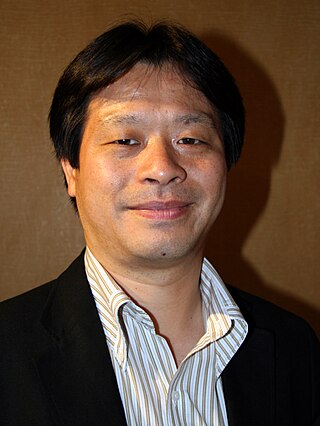
Yoshinori Kitase is a Japanese game director and producer working for Square Enix. He is known as the director of Final Fantasy VI, Chrono Trigger, Final Fantasy VII, Final Fantasy VIII and Final Fantasy X, and the producer of the Final Fantasy X and Final Fantasy XIII series.

Motomu Toriyama is a Japanese game director and scenario writer who has been working for Square Enix since 1994. He initially worked on cutscenes in Bahamut Lagoon and Final Fantasy VII before serving as one of the three directors on Final Fantasy X under Yoshinori Kitase where he was in charge of events.
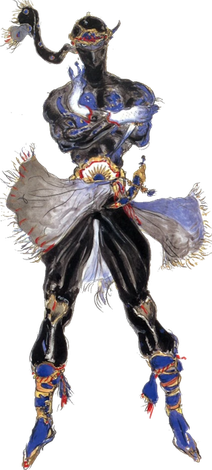
Shadow is a character introduced in the 1994 role-playing video game Final Fantasy VI by Square Enix. He was conceived by Tetsuya Nomura, based on a character class idea he had wanted to utilize in Final Fantasy V. A ninja mercenary, he travels with a canine companion, Interceptor, and is available during certain sections of the game as a party member. Elements of his past may also be revealed to the player, in which they discover he was originally a robber named Clyde, who after the death of his partner in crime abandoned eventually abandoned his past and took on the name Shadow. He has since appeared in other games related to the Final Fantasy franchise, including Dissidia Final Fantasy Opera Omnia, where he is voiced by Yoshito Yasuhara.
Tetsuya Nomura is a Japanese video game artist, designer, producer, and director working for Square Enix. He was hired by Square initially as a monster designer for Final Fantasy V (1992), before being shifted towards secondary character designer alongside Yoshitaka Amano for Final Fantasy VI (1994). Final Fantasy VII (1997) had him working in the original story alongside Hironobu Sakaguchi, and marked his debut as the lead character designer, a capacity he would retain for several future installments of the series, as well as other Square Enix titles such as The Bouncer and The World Ends with You.
Final Fantasy is a media franchise created by Hironobu Sakaguchi, and developed and owned by Square Enix. The franchise centers on a series of fantasy and science fantasy role-playing video games (RPGs). The eponymous first game in the series, published in 1987, was conceived by Sakaguchi as his last-ditch effort in the game industry; the game was a success and spawned sequels. While most entries in the series are separate from each other, they have recurring elements carrying over between entries, including plot themes and motifs, gameplay mechanics, and visual elements.

The Opera House is a level in the 1994 role-playing video game Final Fantasy VI developed by Square. Taking place partway through the game, it occurs when the game's characters require an airship, the only one of its kind, owned by the adventurer and gambler Setzer. The character Celes, a former Imperial general, is a near-double of a famous opera diva named Maria, who Setzer is planning to kidnap during a performance. The characters plan for Celes to switch places with Maria, causing her to be kidnapped in Maria's place and allowing the others to sneak aboard the airship and convince Setzer to let them use it. During the opera, "Maria and Draco", Celes "sings" the song "Aria di Mezzo Carattere" in a cutscene, before the opera is attacked by the recurring antagonist and monster Ultros, forcing the other characters to stage a rescue.

Edgar Roni Figaro and Sabin Rene Figaro are two characters in the 1994 video game Final Fantasy VI. They are main characters who become allied with characters like Terra Branford and Celes Chere while they battle the Gestahlian Empire and Kefka Palazzo. Edgar is the king of Figaro Castle while Sabin trains in the mountains, a deal they arrived at after Edgar rigged a coin flip in Sabin's favor so he would not have to be king. They are both later separated from the others after the end of the world, though they can be reacquired over the course of the second half of the game. They were created by Soraya Saga, who was responsible for their backstory and dialogue.
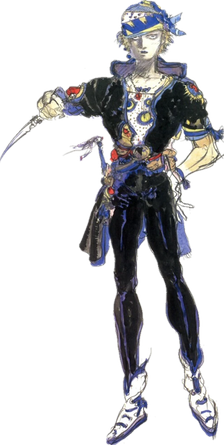
Locke Cole is a character in the 1994 video game Final Fantasy VI.
References
- ↑ "The Making Of: Final Fantasy VI". Edge. 5 August 2013. Archived from the original on 8 August 2013. Retrieved 9 August 2013.
- ↑ Reflections With Soraya Saga Part 1 // Siliconera Archived 12 March 2016 at the Wayback Machine . Siliconera.com (4 June 2010). Retrieved 2011-01-16.
- 1 2 3 4 5 6 7 Schreier, Jason (28 November 2016). "Final Fantasy VI Once Had A Character Named Angela (And Other Little-Known Facts)". Kotaku. Archived from the original on 11 February 2019. Retrieved 22 April 2020.
- 1 2 Final Fantasy: Kitase's Inside Story from Archived 10 January 2013 at archive.today . 1UP.com. Retrieved 16 January 2011.
- 1 2 3 4 Juba, Joe (2 April 2019). "The Best of an Era: Looking Back on Final Fantasy VI After 25 Years". Game Informer. Archived from the original on 26 September 2019. Retrieved 21 April 2020.
- 1 2 Schreier, Jason (15 February 2017). "Final Fantasy VI Retrospective: Simply the Best". Kotaku. Archived from the original on 8 April 2020. Retrieved 21 April 2020.
- 1 2 3 4 5 6 7 8 Edge Staff (8 May 2015). "The making of... Final Fantasy VI". Games Radar. Retrieved 6 May 2020.
- ↑ Arvis: Took you long enough! Busy with all that robbing and plundering, I presume? [...] Locke: I prefer the term "treasure hunting"! Arvis: Ha! Semantic nonsense! Square Enix, Final Fantasy VI Advance (in English), 5 February 2007
- ↑ Studio BentStuff 2008, pp. 152–153.
- ↑ Father: Get out of my house! It's your fault Rachel lost her memory! Locke: Wait! Just let me talk to her...! Rachel: Please, just go away! I don't know who you are, but my parents get upset whenever you come here! Square Enix, Final Fantasy VI Advance (in English), 5 February 2007
- ↑ Locke: A year went by... When I finally returned, I found out that Rachel had been killed in an Imperial attack. Her memory had returned just before she died. The last thing she said was...my name. I never should have left her side. I... I failed her... Square Enix, Final Fantasy VI Advance (in English), 5 February 2007
- ↑ Celes: Why are you helping me? Locke: You remind me a lot of someone... What's it matter, anyway? I'm helping you because I want to! Square Enix, Final Fantasy VI Advance (in English), 5 February 2007
- ↑ Locke: You're all safe! Behold... The legendary treasure that can undo death itself... Player character: Is that... magicite? Locke: It is. Legend has it that the Phoenix turned itself to stone ages ago. Square Enix, Final Fantasy VI Advance (in English), 5 February 2007
- ↑ "Theatrhythm: Final Fantasy's Second Tier Stars". Siliconera. 12 November 2011. Archived from the original on 20 June 2012. Retrieved 1 July 2012.
- ↑ "Jonathon Von Mering". IMDB.com. Archived from the original on 17 February 2017. Retrieved 22 January 2020.
- ↑ Clements, Ryan; Moriarty, Colin (10 January 2012). "The Best Characters of Final Fantasy". IGN. Retrieved 6 May 2020.
- ↑ Celes: I was raised to be an Imperial Magitek knight. When I was still very young, I was artificially infused with magic. Square Enix, Final Fantasy VI Advance (in English), 5 February 2007
- ↑ Sabin: Let's leave this place! Let's forget this crazy kingdom, and live our lives how we want to! You said you didn't want to be a king, right? Edgar: A life of freedom, huh...? Square Enix, Final Fantasy VI Advance (in English), 5 February 2007
- ↑ Edgar: Sabin... Let's settle this with the toss of a coin. Dad gave me this one. If it's heads, you win. Tails, I win. The winner chooses whichever path he wants...no regrets, not hard feelings. Okay? Square Enix, Final Fantasy VI Advance (in English), 5 February 2007
- ↑ Locke: Terra... Wait for me... I won't be gone long. ...And watch out for a certain lecherous young king who shall remain nameless. The guy moves in like a hawk! Square Enix, Final Fantasy VI Advance (in English), 5 February 2007
- ↑ Gerad: Look, I'm kind of busy here. I have to get ready. We're leaving for Figaro on the ferry soon. Celes: Don't play dumb with me! Edgar? ...You didn't lose your memory, did you? Gerad: Listen... It grieves me to have to disappoint such a beautiful lady, but I've been Gerad since the day I was born! Square Enix, Final Fantasy VI Advance (in English), 5 February 2007
- 1 2 3 4 Clements, Ryan; Moriarty, Colin (10 January 2012). "The Best Characters of Final Fantasy". IGN. Retrieved 6 May 2020.
- ↑ Studio BentStuff 2008, pp. 156–157.
- ↑ Sabin: Why, Vargas? Why did you kill Master Duncan? How could you kill your own father!? Vargas: The fool snubbed me, his only son! He chose you as his successor! Square Enix, Final Fantasy VI Advance (in English), 5 February 2007
- ↑ Studio BentStuff 2008, pp. 166–167.
- ↑ O'Connor, Quinton (21 April 2023). "Final Fantasy 6 Pixel Remaster: World Of Ruin Recruitment Guide". The Gamer. Retrieved 1 May 2024.
- ↑ Studio BentStuff 2008, pp. 173.
- ↑ "FF Colosseum". V-Jump (in Japanese). No. 25. July 1995. pp. 192–195.
- ↑ Schreier, Jason (5 September 2017). "Is Squall Really Dead? Final Fantasy Producer Addresses The Series' Biggest Fan Theories". Kotaku . Retrieved 1 May 2024.
- ↑ "Rare Tetsuya Nomura Art Sketches From Final Fantasy VI Era Unearthed". Siliconera . 28 October 2013. Archived from the original on 17 January 2023. Retrieved 16 April 2024.
- ↑ Nintendo Power, ed. (7 November 2004). Final Fantasy I & II: Dawn of Souls Player's Guide. Nintendo of America. ISBN 978-1-930206-55-7.
- ↑ Studio BentStuff 2008, pp. 176.
- ↑ Dunham, Jeremy (15 February 2007). "Review of Final Fantasy VI Advance". IGN. Archived from the original on 3 September 2011. Retrieved 26 July 2009.
- ↑ Turner, Benjamin (9 May 2006). "Review of Final Fantasy VI Advance". GameSpot . Archived from the original on 30 October 2013. Retrieved 26 July 2009.
- ↑ Nintendo Power 250th issue!. South San Francisco, California: Future US. 2010. p. 46.
- ↑ Smith, Dave (15 May 2008). "Top 25 Final Fantasy Characters – Day IV". IGN. Archived from the original on 10 February 2009. Retrieved 26 July 2009.
- ↑ Smith, Dave (12 May 2008). "Top 25 Final Fantasy Characters – Day I". IGN. p. 3. Archived from the original on 12 February 2009. Retrieved 26 July 2009.
- ↑ Smith, Dave (14 May 2008). "Top 25 Final Fantasy Characters – Day III". IGN. p. 2. Archived from the original on 12 February 2009. Retrieved 26 July 2009.
- ↑ Smith, Dave (14 May 2008). "Top 25 Final Fantasy Characters – Day III". IGN. p. 4. Archived from the original on 9 February 2009. Retrieved 26 July 2009.
- ↑ Nintendo Power 250th issue!. South San Francisco, California: Future US. 2010. p. 47.
- ↑ Clements, Ryan (30 July 2009). "Dissidia Final Fantasy: Terra". IGN. Archived from the original on 2 August 2009. Retrieved 6 August 2009.
- ↑ "人気投票" [Popularity Poll]. V Jump (in Japanese). Shueisha. December 1995. pp. 184–187.
Works cited
- Studio BentStuff, ed. (31 January 2008). Final Fantasy 20th Anniversary Ultimania (in Japanese). Vol. 1: Character. Japan: Square Enix. ISBN 9784757522060.